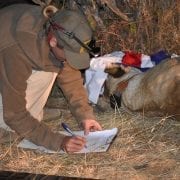New Addition to Loisaba’s Mammal List
We are excited to announce that we have a new addition to Loisaba’s Mammal List; the desert warthog (Phacochoerus aethiopicus)!
The desert warthog is one of Africa’s least studied and most poorly-known large mammals. Although described in 1766, confusion concerning its taxonomy resulted in the recognition of only one species of warthog, the common warthog (Phacochoerus africanus).
‘Rediscovered’ in 1991, the desert warthog differs most noticeably from the common warthog in its warts (hook-shaped rather than cone-shaped) and ears (bent back at the tip rather than erect; see below).

How to most readily differentiate the desert warthog (right) from the common warthog (left) in the field. 1) Warts: adult desert warthog has a hook-shaped wart under the eye, adult common warthog has a cone-shaped wart under the eye. 2) Ears: ear tips of a desert warthog are bend backwards, ear tips of common warthog are erect. 3) Suborbital area: suborbital area (under the eye) appears swollen in adult desert warthog, absent in common warthog. 4) Head: head of desert warthog is ‘egg-shaped’ when viewed from the front, head of common warthog is slightly ‘diablo-shaped’ when viewed from the front. © Yvonne de Jong & Tom Butynski
Previously, a subspecies of the desert warthog (the cape warthog, P.a. aethiopicus) was found in South Africa, but became extinct in the 1870s. This is thought to be due to disease, hunting, human-caused habitat change, and/or competition with livestock.
Now found only in Ethiopia, Kenya and Somalia, the distribution, abundance, ecology, behaviour and conservation status of the desert warthog remain poorly known. A better understanding is not only of considerable scientific interest, it is important to the development of effective conservation and management plans for this species.
Although listed as ‘Least Concern’, there are large areas in Kenya where the desert warthog is naturally absent or at very low density. During dry periods, there are few sources of drinking water and plant productivity is low – meaning higher competition between livestock and wildlife for forage and water. Many protected areas within the range of the desert warthog experience high livestock densities during the dry seasons, and are affected by insecurity and poaching.
In February 2021, Yvonne de Jong and Tom Butynski visited Loisaba as part of their study of the distribution and conservation status of the desert warthog in Kenya and Horn of Africa. During their two-day visit they obtained the first record for desert warthog at Loisaba (the 4th location in Laikipia, along with Lekurruki Conservancy, Il’Ngwesi Conservancy, and Suyian Ranch). “Loisaba has at least one sounder of four (2 adult females and 2 subadult females) and possibly a sounder of both desert warthogs and common warthogs”. Thanks to our carefully managed cattle grazing programmes and excellent security (0 poaching incidences at Loisaba since 2017), we are proud to be able to provide safe habitat for the desert warthog.
Yvonne and Tom’s updated desert warthog distribution map is completed and ready to be published. There are still, however, many questions that remain unanswered: Does the desert warthog interbreed with the common warthog? Did this species only recently arrive in Laikipia? Where else is it found in Laikipia?
How You Can Help
Have you seen desert warthog in Kenya? To help answer some of these questions, and to better understand the distribution of desert warthogs, details and a photograph of your encounter would be highly appreciated. The following information is most helpful:
- Date of sighting
- Name of nearest village or town
- Latitude and longitude
- Elevation
- Habitat
Please send the details and image of your sighting to [email protected] or [email protected].













Leave a Reply
Want to join the discussion?Feel free to contribute!